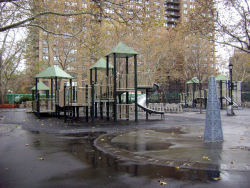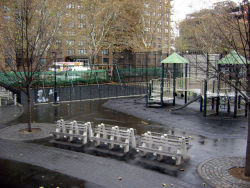Pratt Playground
Pratt Playground
This park is named for Charles Pratt (1830-1891), philanthropist, businessman, and founder of the Pratt Institute. After working for a Boston company that specialized in whale oil products, Pratt moved to New York to establish the Astral Oil Company. The business grew quickly and eventually merged with John D. Rockefeller’s Standard Oil. Although Pratt’s fortune helped him become a leading figure in Brooklyn, he regretted his meager education and hoped to establish a school where students could learn manual trades. He fulfilled this dream in 1887 when he founded the Pratt Institute, which offered the first manual training high school in New York City. The school inspired programs at other institutions, including the Carnegie Institute of Technology and the Drexel Institute. Though only twelve students attended Pratt in its opening year, it now has more than 3,700 students. The Institute’s famous alumni include Robert Redford (actor and director), Ellsworth Kelly (painter), William Boyer (designer of the classic Thunderbird automobile), Betsey Johnson (fashion designer), William Kissiloff (designer of the National Baseball Hall of Fame), Ed Koren (cartoonist for the New Yorker magazine), Pete Hamill (journalist and author), Jules Feiffer (cartoonist and playwright), and David Sarnoff (CEO and president of RCA corporation), among others. Pratt also helped build the Emmanuel Baptist Church, founded the Pratt Institute Free Public Library (the first of its kind in Brooklyn or Manhattan), and organized the Thrift, one of Brooklyn’s first savings and loan institutions.
Both Pratt Playground and the Pratt Institute are both part of the Clinton Hill historic district. The area was originally farmland owned by the Ryerson family. In the 1830s, the land was subdivided and developed, and by the 1880s, it had become known as a suburban retreat. Four of the mansions that Charles Pratt built for his sons are still in place at 229, 232, 241, and 245 Clinton Avenue. In the early 1950s, the area was rejuvenated through a neighborhood redevelopment program. The streets surrounding the Pratt Institute were reorganized in 1956, when Steuben, Grand, and Ryerson Streets were closed between Willoughby and Myrtle Avenues, creating the superblock known as Willoughby Walk.
As part of a plan to redevelop the area, Pratt Institute gave this lot to the City in-- 1959. The playground originally contained slides, swings, see-saws, a shower basin, sand pit, slides, a jungle gym, games area with tables and benches, and a public restroom. Today, the basketball courts and games areas are popular with neighborhood residents. Designs are currently underway for a major renovation to the playground.
Check out your park's Vital Signs
Clean & Safe
Green & Resilient
Empowered & Engaged Users
Share your feedback or learn more about how this park is part of a
Vital Park System


